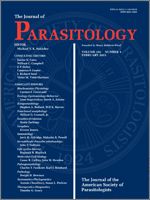Pond snails (Physa acuta) were exposed to a gradient (0, 1, 3, 5, 10, 15, 20, 25, 30, 35, 40, and 50) of trematode (Halipegus eccentricus) eggs and observed to determine egg dose effects on the survival of snails through the prepatent period, snail reproduction, and the production of cercariae. The probability of snail survival through the prepatent period significantly decreased with increasing egg exposures, where the odds of snail survival was 0.94 per trematode egg. Similarly, the probability of snail reproduction significantly decreased with increasing egg exposures, where the odds of snail reproduction was 0.85 per trematode egg. In contrast, the probability of a snail shedding cercariae significantly increased with increasing egg exposures, where the odds of reaching a patent infection were 1.64 per trematode egg. However, snails shedding cercariae that were exposed to higher doses of trematode eggs tended to die sooner. Thus, there appears to be a tradeoff between infecting a snail and killing the host.
BioOne.org will be down briefly for maintenance on 17 December 2024 between 18:00-22:00 Pacific Time US. We apologize for any inconvenience.
How to translate text using browser tools
1 February 2015
Tradeoff Between Establishing an Infection and Killing the Host: Response of Snails ( Physa acuta) to a Gradient of Trematode (Halipegus eccentricus) Exposures
K. D. Gustafson,
M. G. Bolek
ACCESS THE FULL ARTICLE

Journal of Parasitology
Vol. 101 • No. 1
February 2015
Vol. 101 • No. 1
February 2015




